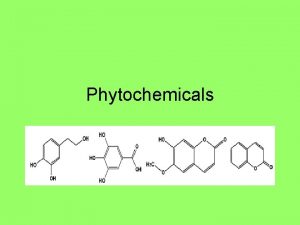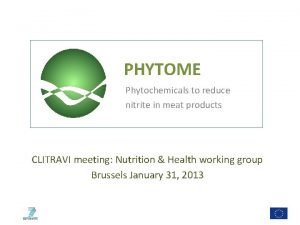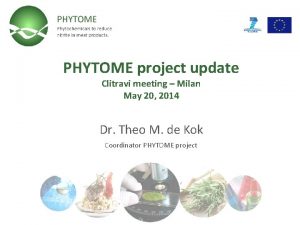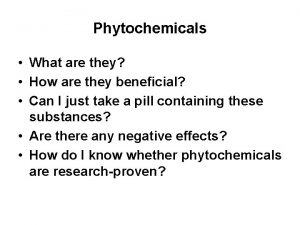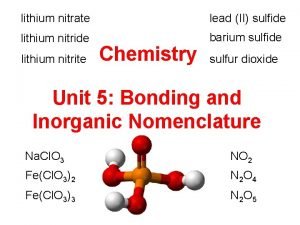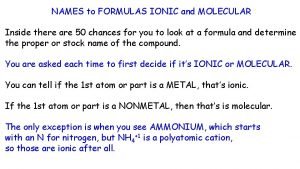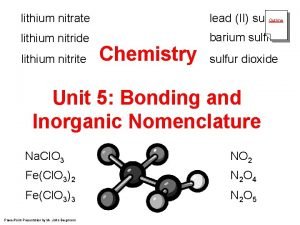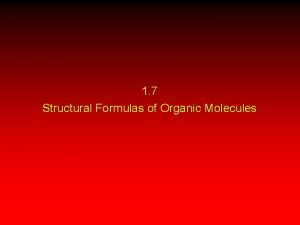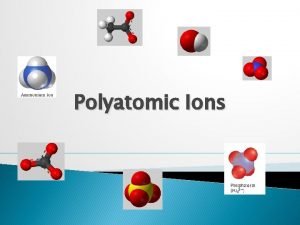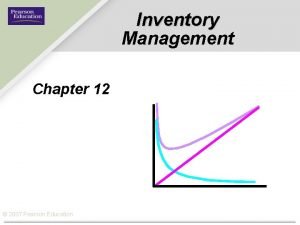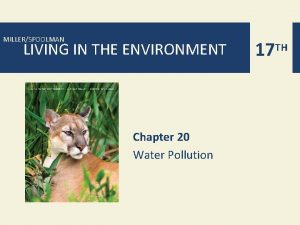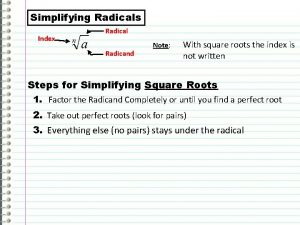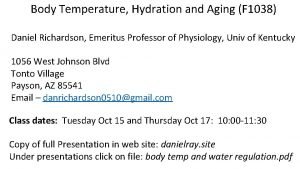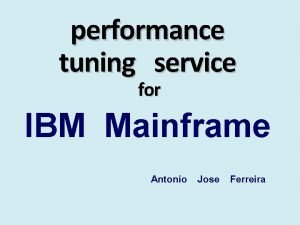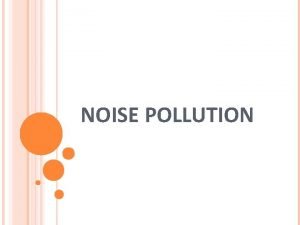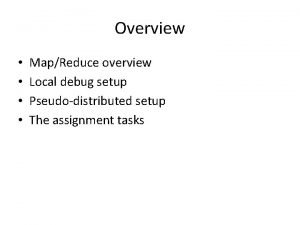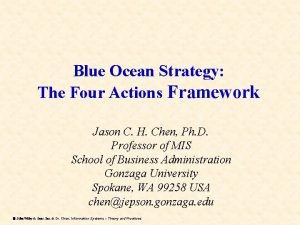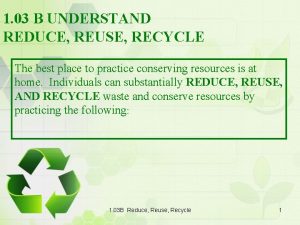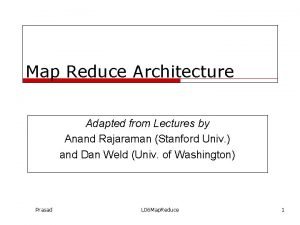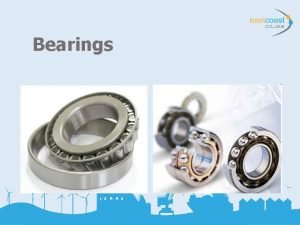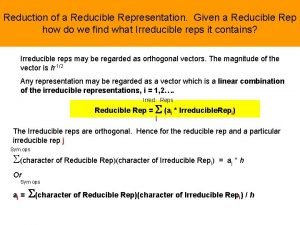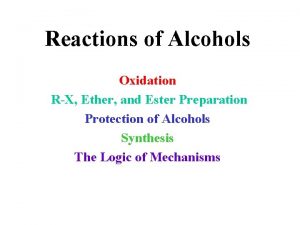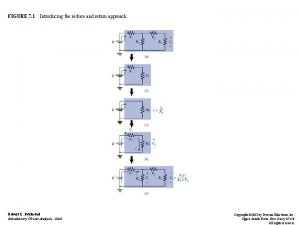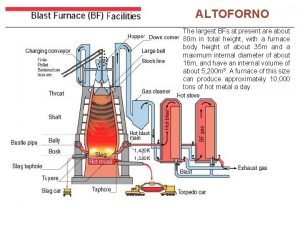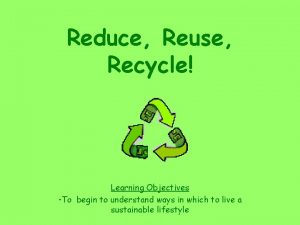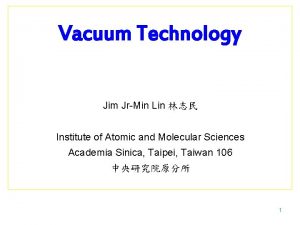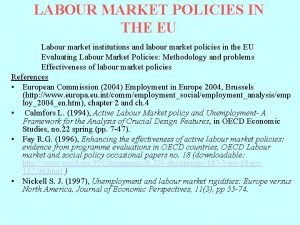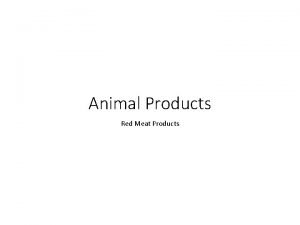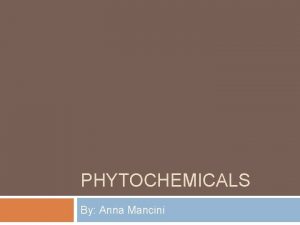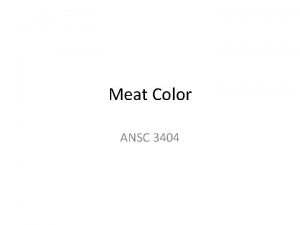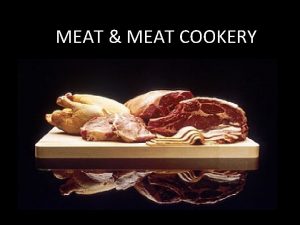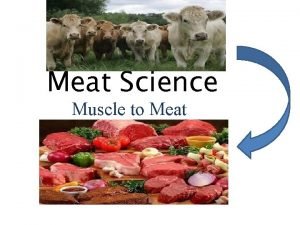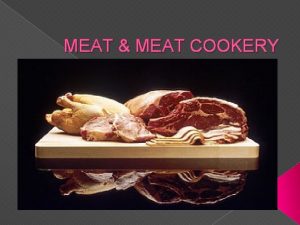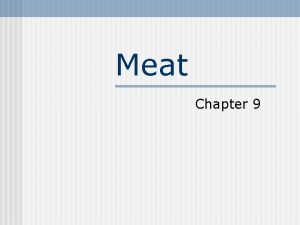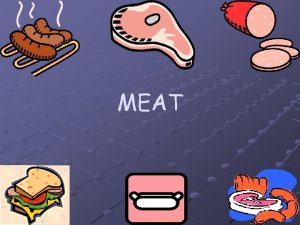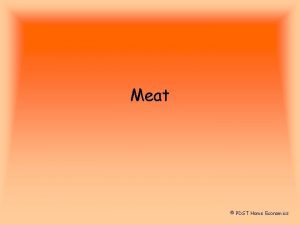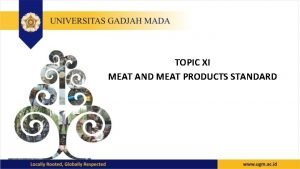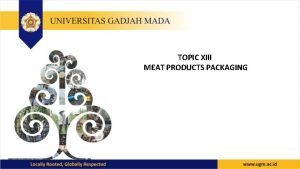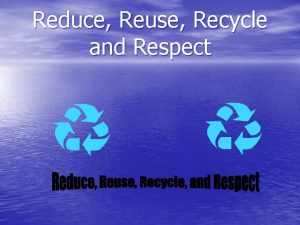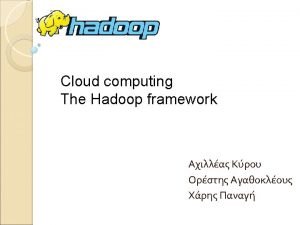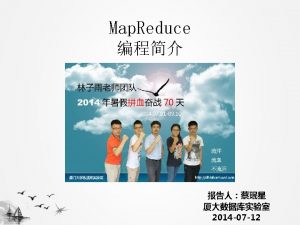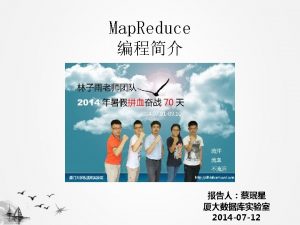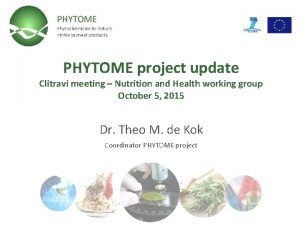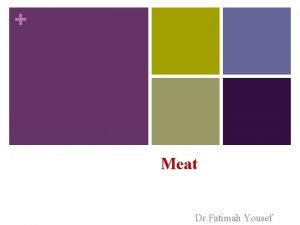PHYTOME Phytochemicals to reduce nitrite in meat products





















































- Slides: 53

PHYTOME Phytochemicals to reduce nitrite in meat products CLITRAVI meeting: Nutrition & Health working group Brussels January 31, 2013

Project overview Main goal of the project: to develop new meat processing technologies, resulting in innovative meat products that have low or no nitrite, that contribute to human health and are attractive for the consumers.

Project overview Overall objectives: 1 Design innovative meat products - 2 3 4 5 6 7 from reactive to pro-active: food innovation Improve position in a specific market segment (the benefit of SMEs) Produce and evaluate prototype products Evaluate health impacts Establish consumer responses Design marketing strategies Disseminate the outcome to SME members Demonstrate the potential of the concept

Consortium partners

Project overview PHYTOME is a very special project - Bringing science to industry (SME-AG / SME /RTD collaboration) Valorisation of new knowledge (Economic objective) Promoting human health (Public Health objective) Advancement of scientific knowledge (Scientific objective). Achievements - Defining a common goal for this project proposal Building a balanced consortium Submitting a project proposal A grant agreement!

Project overview

Management structure

External advisory committee • Dr Monica Flores: (Chair) Nutrition & Health group (CLITRAVI) • Dr. Kees de Gooijer: Food and Nutrition Delta, Wageningen, NL. • International Life Sciences Institute (ILSI): Diana Banati or Stephane Vidry • Dr. Rashmi Sinha (National Cancer Institute, Bethesda USA) • External ethical advisor

Rationale behind PHYTOME The World Cancer Research Fund (WCRF) classifies epidemiological evidence sufficient to link meat consumption to colon cancer risk. Mechanism of action involves the endogenous formation of Nnitroso compounds (NOC); NOC formation is stimulated by haem iron and nitrite in preserved meat products; NOC are carcinogenic in animals and have different modes of action

Rationale behind PHYTOME The World Cancer Research Fund (WCRF) confirms the protective effects of vegetables and fruits against colon cancer. The protective effect is attributed to specific bioactive compounds (phytochemicals); Some phytochemicals are known to reduce NOC; Phytochemicals are known to counteract NOC- associated modes of action; Specific phytochemicals are known to have antioxidant, and antimicrobial capacities.

Rationale behind PHYTOME Research hypothesis: Reduction or replacement of nitrite in meat products by a combination of phytochemicals will result in the production of meat products that are: - microbiologically safe of good sensory quality not stimulating endogenous formation of NOC improve human gut health attractive for consumers.

Workpackage 2 WP 2: Investigation of meat model systems added with different amounts of phytochemicals and nitrite. A feasibility study. OBJECTIVES O 2. 1 To select a range of plant extracts (containing phytochemicals) and red plant pigments whose physical and chemosensory properties make them eligible for use with meat products. O 2. 2 To define the best procedures for the addition of selected plant extracts and pigments to meat model systems designed to represent the major meat categories. O 2. 3 To find what combinations between the plant extracts and nitrite (including a no nitrite option) and plant pigments give the best physical and chemosensory results in the meat model systems under investigation.

Workpackage 2 Task 2. 1 Selection of phytochemicals and plant pigments. Literature review of current knowledge on phyto and pigment of plant extracts. Determination of the phytochemical concentration in candidate plant extracts. (in connection with WP 4 -Task 4. 1 UM) Task 2. 2 Development of procedures of the addition of extracts. Solubilisation and addition of selected plant extracts in meat model system.

Workpackage 2 Task 2. 3 Selection of candidate plant extracts. Based on solubility, stability and sensory, a number of candidate plant extracts/pigments and their concentration ranges to be used in the meat matrices will be selected. (SSICA, UM) Task 2. 4 Testing phytochemical- nitrite combinations in meat model system. (phytochemicals blend will be tested in different model systems; sensory, chemical and safety analysis aimed at identifying most promising mixture; sensory profile assessed in collaboration with VDBILT and LUSETTI)

Workpackage 2 • REQUIREMENTS • Bioactive substances • Sensory, • Microbial, • Solubility properties From natural plant extract To selected blend of phytochemicals • SUPPLEMENTATION LEVEL • Quantity which is believed to give effective health protection • Concentration at which phytochemical are soluble • EVALUATION IN MEAT MODEL SYSTEM • Phytochemicals still active • Sensory properties To new health formulation

Workpackage 2 Blend of Phytochemicals (from Task 2. 3) will be introduced in different meat model systems by means different techniques. • Dry cured sausage • Cooked sausage • Dry cured ham • Cooked ham Evaluations on the final products will be performed to assess: • active phytochemicals and ascorbic acid • sensory profile (VDBILT, LUSETTI) • oxidative stability Aiming at identifying most promising combinations of phytochemicals and technologies.

Workpackage 3 WP 3: Production of healthy meat products O 3. 1 To provide guidelines for the manufacturing of meat products (MPs). (how to prepare MPs; what phytochemicals, pigments, with or without nitrite). O 3. 2 To Manufacture the MPs at an industrial level. (obtaining real meat products according to given procedures) O 3. 3 To evaluate the MPs (obtaining relevant sensory, chemical, microbiological profiles) O 3. 4 To analyze the data (inspecting and interpreting data from meat manufacturing)

Workpackage 3 Task 3. 1 Techniques and formulations for the manufacturing of MPs (meeting with industrial partners); Month 10 -11. Task 3. 2 Industrial scale manufacturing of MPs (industrial partners to prepare MPs) Month 10 -24 VDBILT LUSETTI VDBORRE SSICA

Workpackage 3 Task 3. 3 Analysis of MPs testing MPs for sensory, chemical profiles. Assaying residual phytos and N-NOCs; microbiology: month 10 -28 SSICA and UREAD Task 3. 4 Statistical analysis of manufacturing data: month 24 -32 SSICA

Workpackage 3 Real meat products prepared to incorporate selected phytochemicals and no or reduced nitrite. Products passed to intervention and consumer studies

Workpackage 4 WP 4: In vitro pre-screening studies D 4. 1 D 4. 2 Report selection phytochemicals Report effects of extracts LB 1 M 12 Task 4. 1: Literature search on phytochemicals and their activities - Antioxidant activity Antimicrobial activity Contributing to sensory aspects Inhibition of nitrosation.

Pre-screening studies Pilot study: pre-selection of phytochemicals

Pre-screening studies Phytochemicals evaluated: Ascorbic acid, EGCG (Green tea polyphenol), carnosoic acid, carnosol, curcumin, resveratrol, quercetin, cyanidin, di-alyl-disulfide, eugenol, genistein, lycopene, malvidin, rosemarinic acid, thymol. Pre-selection resulted in the most promising candidates: Ascorbic acid, Quercetin, Resveratrol evaluation in the in vitro cell system EGCG

Pre-screening studies Task 4. 2: Assessment of biological activity of natural extracts - Human colon Caco-2 cells Pre-incubation with phytochemicals and exposure to NOC Evaluation of radical scavenging (ESR) Evaluation of DNA protection (COMET-assay). - Comparison isolated compounds versus complex extracts

Pre-screening studies DNA damage test: Comet assay.

Pre-screening studies DNA damage test: Comet assay. A = no damage B – D = increasing damage E = maximal damage F = apoptotic cell

Pre-screening studies Measuring radical mediated processes - Highly reactive: can easily damage DNA and proteins - Shortlived < msec. : difficult to measure Electron spin resonnance spectroscopy (ESR) > Spintrapping agent stabilized different radicals Oxygen radicals (ROS) Carbon centred radicals (CCR)

Pre-screening studies Results

Pre-screening studies

Pre-screening studies Combinations of phytochemicals

Pre-screening studies From phytochemicals to complex natural extracts. Inventory of commercial extracts is needed: - Frutarom - - Grape Seed Activin – Resveratrol Green Tea PE 50/35/15 Origanox WS LB Vitiva Martin Bauer Nestle Smood …. Good chemical characterization is crucial (Uread)

Pre-screening studies MS 4. 1 Advise WP 4 > WP 2 on use of phytochemicals Advise should integrate: - Chemical characteristics / composition of extracts - Adequate levels achievable - Effective in meat products Effective internal dose to induce preventive effects - New candidates - Impact on sensory quality - Contribution of microbiological food safety LB 1 M 6

Pre-screening studies - Chemical analysis (Uread)

WP 5 Human study D 5. 1 Proposal Medical Ethics Review Cie. D 5. 2 Ethical clearance D 5. 3 Report on health effects LB 1 M 3 LB 1 M 12 LB 1 M 36 Task 5. 1 Design of a human intervention study for MEC approval Critical aspects: - Study design - Inclusion and exclusion criteria - Study duration - Control group (white meat) - Control and composition of total diet (nitrate/phytochemicals) - Sampling frequency, conditions, timing, amounts, distribution - Analyses, etc…

WP 5 Human study Proposed design: - What is low meat? - Sampling at t = 0? - Time per section is 15 days - Sampling of blood, urine faeces, biopsies - Also sampling of saliva (nitrate/nitrite ratio); mouth wash; buccal cells?

WP 5 Human study Overview of different analyses: - Faecal nitroso compounds (ATNC) Faecal water genotoxicity (Comet assay) DNA damge (O 6 -carboxy methylguanine / O 6 -methylguanine) Gene expression analysis (transcriptomics) Epigenetics (DNA-methylation)

WP 5 Human study Genomics techniques in human studies Environmental or dietary factor Human disease Exposure results in specific response profiles

WP 5 Human study Genomics techniques Agilent microarryas: 44. 000 signals

WP 5 Human study Data analysis and interpretation - Identification of genes that are differently expressed before and after; or that correlate with one of the other endpoints; - Up-regulation or down-regulation of genes provides information on biological processes that are modulated - Changes in biological processes are related to disease risk - The impact of the dietary changes can be interpreted in relation to disease risk.

WP 5 Human study Previous results linking faecal genotoxicity to gene expression in a dietary intervention study in inflammatory bowel disease patients • Fecal NOC were demonstrated in the majority of subjects • Correlations between NOC and relevant gene expression changes

WP 5 Human study • The increased fecal water genotoxicity of the red meat intervention was also associated with relevant gene expression changes:

WP 5 Human study • Epigenetics? Hebels et al. , Cancer Letters, 2011; 309: 1 -10

WP 6 Consumer studies Objectives O 6. 1 Obtaining insights into consumer attitudes towards meat products contributing to better gut health O 6. 2 Mapping consumer reactions towards meat products developed in PHYTOME O 6. 3 Identifying possible strategies to recover the extra costs for processing healthier meat products

WP 6 Consumer studies T 6. 1 Qualitative focus groups • M 3 - M 24 • Exploring consumer and stakeholder opinions on marketing meat products contributing to better gut health • 4 European countries; 2 focus groups per country: one consumer; one stakeholder • Stakeholder participant selection via PHYTOME partners

WP 6 Consumer studies T 6. 2 Quantitative consumer survey • M 16 -M 30 • Large scale online consumer survey • Questionnaire development in close collaboration with end-user partners • Topics: perceptions, attitudes, behaviour, acceptance, information needs and preferences • 3 European countries • n=500 per country

WP 6 Consumer studies T 6. 3 Experimental consumer study • M 24 -M 36 • Consumer appeal and acceptance of different meat products • Experimental auctions/discrete choice study • 2 EU countries

WP 7 Dissemination WP 7 – Task 1 Disseminate knowledge on meat processing technologies, health impact and consumer sciences within the consortium 1. Training workshop on technological procedures (from RTD to other end-users) – venue: Parma, date: as from M 06 (= as from June 2013) 2. Training workshop on health impacts and consumer attitudes (from RTD to other end-users) – venue to be decided (Ghent? ), date: to be decided depending on WP 6

WP 7 Dissemination WP 7 – Task 2 Share the results of the project to the members of the SME associations. 1. Organise a session @ national level during general meetings of VNV and Fenavian allowing the consortium to present project results (M 36) 2. Organise a session @ CLITRAVI’s meeting to present project results (M 36) – regular update Already inform members of SME AG about the project

WP 7 Dissemination 3. Prepare a flyer presenting outline and results of the project for pr activities 4. Prepare a video presenting outline and results of the project for pr activities 5. Set-up a dedicated web-site (with restricted access area for project partners) 6. Produce digital newsletters to inform about progress of the project (2 per year? to whom? ) MAKING USE OF EXISTING COMM. TOOLS OF CLITRAVI MEMBERS (e. g. newsletters)

WP 7 Dissemination WP 7 – Task 3 Disseminate and discuss the outcome of project with various stakeholders Organisation of meetings with different stakeholders to present project results (last year of project): • • • national level (key stakeholders to be identified, e. g. consumers assoc. , retailers, governmental experts) EU level (EC, EP, EFSA, others? ) international level: dedicated session to be organised at ICOMST (2015 or 2016 edition? )

WP 8 Demonstration T 8. 1 To apply the procedures and technologies developed at SSICA in different types of meat products: M 24 -M 36 - A series of meat products with added natural extracts in combination with reduced nitrite will be produced T 8. 2 To evaluate the quality of the produced meat products: M 24 -M 36 - Evaluation of the microbiological safety at SSICA - Evaluation of the sensory quality at the participating other end-users T 8. 3 To evaluate consumer responses: M 26 -M 36 - Designing of new labels, indicating relevant information on product composition and characteristics. - Present product and label text at food exhibitions and meetings with retailers

PHYTOME Kick-off

PHYTOME
 Phytochemicals
Phytochemicals What are phytochemicals
What are phytochemicals Phytome
Phytome Phytome
Phytome Phytochemicals food chart
Phytochemicals food chart Ncnh lewis structure
Ncnh lewis structure Lead ii nitrite
Lead ii nitrite Bismuth nitrite
Bismuth nitrite Lead ii nitride
Lead ii nitride Cacn2
Cacn2 Ncnh lewis structure
Ncnh lewis structure Monatomic ion definition chemistry
Monatomic ion definition chemistry List down the available market forms of poultry
List down the available market forms of poultry Functional product
Functional product Pepsi products vs coke products
Pepsi products vs coke products The ratio used to enlarge or reduce similar figures
The ratio used to enlarge or reduce similar figures Tujuan teknologi ramah lingkungan
Tujuan teknologi ramah lingkungan The primary lever to reduce anticipation inventory is to
The primary lever to reduce anticipation inventory is to Methods to control water pollution
Methods to control water pollution How to reduce the index of a radical
How to reduce the index of a radical Excess heat reduce
Excess heat reduce Map reduce combine
Map reduce combine Mainframe performance optimization
Mainframe performance optimization Solution is
Solution is Map-reduce
Map-reduce Reduce reuse recycle adalah
Reduce reuse recycle adalah 4 action framework
4 action framework Make a poster reduce reuse recycle
Make a poster reduce reuse recycle Lisp map reduce
Lisp map reduce Document
Document Regularity in vlsi
Regularity in vlsi How ball bearings reduce friction
How ball bearings reduce friction How to reduce solid waste
How to reduce solid waste Map reduce word count
Map reduce word count Using citys heat reduce emissions
Using citys heat reduce emissions Map-reduce
Map-reduce How to reduce a reducible representation
How to reduce a reducible representation Alcohol ester reaction
Alcohol ester reaction Boylestad
Boylestad Reducing the development gap tourism
Reducing the development gap tourism How does intermediate technology reduce the development gap
How does intermediate technology reduce the development gap Mapreduce simplified data processing on large clusters
Mapreduce simplified data processing on large clusters Lcm of 3 and 4 and 5
Lcm of 3 and 4 and 5 Rational number simplifier
Rational number simplifier Excess heat reduce
Excess heat reduce Fungsi transfer
Fungsi transfer Oxidation reduction reactions
Oxidation reduction reactions Mapreduce شرح
Mapreduce شرح Map reduce program
Map reduce program Objectives of reduce, reuse, recycle
Objectives of reduce, reuse, recycle Molecular sieve
Molecular sieve Google map reduce
Google map reduce Ways to reduce poverty
Ways to reduce poverty Policies to reduce unemployment
Policies to reduce unemployment

